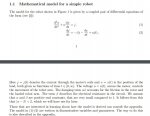Please see the attached details.

The questions is:

How do I solve this problem?
I have tried to solve the characteristic polynomial which gave me -1/2 with multiplicity 2. Thus giving me y(hom) = c1*exp(-1/2t)+c2*t*exp(-1/2t)
I now that the solution is y = y(hom)+y0 where I got y(0) = A*sin(2t)+B*cos(2t)
But I'm not quite sure where I went wrong.
Thank you in advance!

The questions is:
How do I solve this problem?
I have tried to solve the characteristic polynomial which gave me -1/2 with multiplicity 2. Thus giving me y(hom) = c1*exp(-1/2t)+c2*t*exp(-1/2t)
I now that the solution is y = y(hom)+y0 where I got y(0) = A*sin(2t)+B*cos(2t)
But I'm not quite sure where I went wrong.
Thank you in advance!
